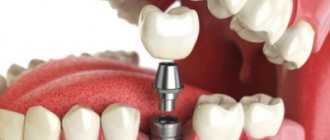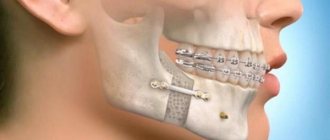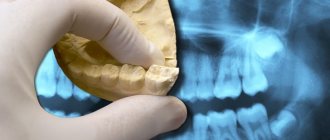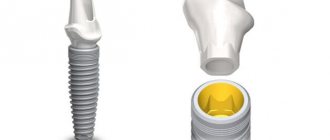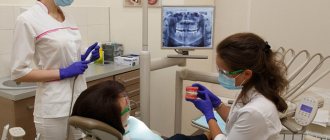Author of the article: Kryukov Andrey Vladimirovich
Chief physician. Doctor-expert
Specialization: Dentist-orthopedist
Total work experience: since 2005
Reading time: 7-8 minutes
Orthopedics in dentistry is a branch of medicine that deals with the restoration of teeth using all modern prosthetic techniques. It is not surprising that an orthopedic dentist is popularly known as a prosthetist. To preserve decaying teeth or restore the attractiveness of your smile, it is important to know with what symptoms you need to go to this specialist, what methods he uses and what results he guarantees.
How is the appointment going?
At the first appointment, the orthopedic doctor collects all the necessary data - asks the patient about complaints and expectations, does a CT scan and examines the oral cavity.
Next, the doctor analyzes the data obtained and offers treatment options, calculating the budget for the work to be done.
And at every appointment, you can watch a movie on the screen and have a good time instead of focusing on the sensations in your mouth.
- Symptoms and conditions requiring consultation with an orthopedic dentist
- Microprosthetics: correction of minor defects
- Removable prosthetics: classics
- Fixed prosthetics: long-term treatment of insufficient dentition
- Implantation is a modern dental orthopedics service
- Appointment with an orthopedic dentist: features
- Equipment and materials used in orthopedic dentistry
- Orthodontist or orthopedist: so as not to be confused
- The best orthopedic dentists in Moscow
Among dentists there are also highly specialized specialists. When it comes to saving the integrity of the dentition or restoring it, an orthopedic dentist comes to the rescue. After all, not all patients really realize that the oral cavity requires constant attention, competent care and timely treatment. And after N number of days, weeks, months, years, the moment comes when they go to the clinic in the hope of getting rid of problems through the use of conservative medicine methods. But they are referred to this specialized specialist. The latter gives, although artificial, a new and beautiful smile, the opportunity to use teeth for their intended purpose, using the capabilities of a dental laboratory.
Work priorities
Our department employs orthopedic dentists with extensive experience who have all the necessary modern equipment at their disposal. They can offer you different treatment options and help you make the right choice. We do not impose the most expensive services on our patients, but select the best option in each specific case.
The administration of CELT JSC regularly updates the price list posted on the clinic’s website. However, in order to avoid possible misunderstandings, we ask you to clarify the cost of services by phone: +7
| Service name | price, rub) |
| Prosthesis reinforcement | 10 000 |
| Bar design with screw fixation on implants | 255 000 |
| Clasp prosthesis “Quattrotti” | 57 000 |
| Double-sided clasp prosthesis with locks | 71 000 |
| Double-sided clasp prosthesis using Bredent locks | 50 000 |
| Clasp prosthesis on telescopic crowns | 125 000 |
| Clasp denture with nylon base | 48 000 |
| Clasp prosthesis standard | 38 000 |
| Clasp prosthesis splinting | 43 000 |
| Veneer, occlusal inlay | 22 500 |
| Stump inlay made of precious stones. alloy (without metal cost) | 16 000 |
| Stump inlay made of precious stones. alloy dismountable (without metal cost) | 19 000 |
| Ceramic core inlay (zirconium oxide) | 22 000 |
| Stump inlay lined with ceramics | 11 000 |
| Stump inlay with “Bredent” attachment | 12 000 |
| Silver-palladium stump inlay | 11 000 |
| Collapsible silver-palladium stump inlay | 13 200 |
| Collapsible one-piece stump inlay | 8 200 |
| Solid stump inlay | 6 000 |
| Temporary fixation of a crown (made in another clinic) | 800 |
| Secondary crown | 4 000 |
| Additional cast clasp | 7 500 |
| Replacing the plastic matrix in a clasp prosthesis | 4 500 |
| Making a diagnostic model from plaster | 650 |
| Making a diagnostic model from supergypsum | 1 100 |
| Making a custom spoon | 2 200 |
| Making a bite template | 1 650 |
| Making a bite template on a hard base | 2 200 |
| Making a Surgical Template | 25 000 |
| Immediate prosthesis (before tooth extraction) | 25 000 |
| Custom tray for implant-supported structures | 5 500 |
| Custom Zirconium Oxide Abutment | 32 000 |
| Using a retraction thread | 300 |
| Whitening tray | 7 500 |
| Ceramic crown on a zirconium oxide implant | 41 000 |
| Temporary crown on an implant (direct method) | 7 000 |
| Temporary crown made in the laboratory | 4 000 |
| Temporary crown made by direct method | 2 500 |
| Ceramic crown “E-MAX” | 30 000 |
| Ceramic crown on zirconium oxide | 30 000 |
| Metal-ceramic crown (economy) | 9 300 |
| Metal-ceramic crown (elite) | 21 700 |
| Metal-ceramic crown for precious stones. alloy (without metal cost) | 25 000 |
| Metal-ceramic crown for precious stones. alloy (without metal cost) MASTERTEKHNIK | 27 000 |
| Metal-ceramic crown with shoulder mass | 14 500 |
| Solid crown | 5 500 |
| The crown is solid cast from precious stones. (special) alloy (without metal cost) | 16 500 |
| Metal-ceramic crown on an AstraTech implant (screw fixation) | 41 000 |
| Metal-ceramic crown on an AstraTech implant (cement fixation) | 35 000 |
| Metal-ceramic crown on an implant “Implantium” (cement fixation) | 31 800 |
| Metal-ceramic crown on the “Inno” implant (screw fixation) | 36 500 |
| Metal-ceramic crown on an implant “MIS” (screw fixation) | 27 000 |
| Metal-ceramic crown on an implant MASTERTECHNIK | 45 000 |
| Soft lining for removable dentures (up to 6 months) | 7 000 |
| Soft lining of the removable denture bed (temporary) | 3 500 |
| Spraying a clasp denture | 7 500 |
| Ceramic veneer (1 crown) | 10 000 |
| Veneering with Shofu composite, Japan (1 crown) | 11 500 |
| Primary crown | 4 500 |
| Relining a prosthesis made in another clinic or after the warranty period expires | 10 000 |
| Complete removable denture "Velplast" | 48 000 |
| Complete removable denture "Ivocril" | 30 000 |
| Complete removable denture “Estedent” | 23 000 |
| Complete removable denture on implants | 110 000 |
| Complete removable denture on implants (reinforced) | 135 000 |
| Complete removable denture with fixation on “Bredent” locking connections | 33 000 |
| Obtaining a two-layer impression | 1 100 |
| Permanent fixation of a crown (made in another clinic) | 1 500 |
| Repairing a linear fracture | 8 000 |
| Welding 1 – 2 teeth | 8 000 |
| Welding one clasp | 8 000 |
| Application of gum mass | 3 300 |
| Application of the ASTRATECH standard abutment | 14 000 |
| Application of standard aba | 11 000 |
| Alginate impression | 600 |
| Removing a metal-stamped crown | 600 |
| Removing a metal-ceramic, solid-cast crown | 1 000 |
| Conditionally removable prosthesis on implants with a beam structure, with beam fastening | 200 000 |
| Conditionally removable prosthesis on implants with a telescopic design | 200 000 |
| Formation of ceramic gums | 3 000 |
| Milling a crown for a partial denture | 7 700 |
| Friction pin | 9 200 |
| Partial removable denture 4 – 13 teeth “Velplast” | 42 000 |
| Partial removable denture 4 – 13 teeth “Ivocril” | 22 000 |
| Partial removable denture 4 – 13 teeth “Estedent” | 16 000 |
| Partial removable denture up to three teeth “Velplast” | 38 000 |
| Partial removable denture up to three teeth “Ivocril” | 16 000 |
| Partial removable denture up to three teeth "Ested" | 11 000 |
| Aesthetic modeling “wax-up” (1 unit) | 1 500 |
At CELT you can get advice from a dental specialist.
- The cost of an orthopedic consultation is 1,000
Make an appointment
Orthopedic services in dentistry at MK CELT include the use of X-ray diagnostics, computed tomography and planning, which allows you to find the ideal solution to any, even the most complex problem. Thanks to cooperation with the best laboratories in the capital, we are confident in the decent quality of any work.
Prices for orthopedic dentistry services are calculated individually in each individual case. Our patients can be confident that the choice of treatment will be made in full accordance with their individual characteristics and financial capabilities. Our orthopedists provide complete information about the pros and cons of certain methodologies and answer all questions that interest our patients.
Symptoms and conditions requiring consultation with an orthopedic dentist
A visit to a doctor in this specialty is important when:
- absence of teeth, regardless of the number (one or all);
- complete or partial destruction of dental units;
- increased tooth mobility;
- cosmetic defects of dental units;
- suspected or established pathology of the temporomandibular joint;
- recommendations from a general or other specialized dentist.
An orthopedic dentist in Moscow helps people experiencing both physical and psychological discomfort associated with problems with the integrity, size, shape and color of the dentition. It can relieve pain, discomfort during chewing and talking, help get rid of speech problems, make a person more attractive, etc. The work of this specialist cannot be overestimated.
What is prosthetic dentistry?
Orthopedics is a separate medical field. This section of dentistry is aimed at treating congenital defects and acquired problems of the dental system. Orthopedic dentistry in Moscow is a common and popular service, the price of which varies depending on the complexity of the situation, the age of the patient and the design features that will have to be used to eliminate the disease or defect.
Orthopedics is inextricably linked with surgery and traumatology. The main goal of the dentist in this regard is the restoration of bone tissue and the treatment of ailments that can affect its condition.
The tasks of an orthopedist include:
- Microprosthetics;
- Installation of removable dentures;
- Fixed prosthetics.
Microprosthetics: correction of minor defects
Chips, cracks, unsightly enamel color, cavities that cannot be helped by a filling - all these problems can be solved using the following designs:
- Veneers. They are thin plates that are placed on the front surface of the incisors. Their main function is to make the patient look more presentable and hide imperfections in the smile area.
- Lumineers. In essence, they are no different from veneers. However, they are inferior in thickness, are more fragile, and not everything can be hidden from the eyes of strangers. One of the advantages is that installation is possible without preliminary grinding of the tooth.
- Tabs, overlays (inlay, overlay). They are used instead of fillings, have a longer service life, and are made of ceramics with improved performance characteristics.
The best orthopedic dentists in Moscow try to focus on microprosthetics options in their practice. This is a more modern way to maintain the attractiveness of your smile.
Removable prosthetics: classics
“False jaws” is the first association that arises in patients when they mention orthopedic dentistry. Just a couple of decades ago, such constructions were practically the only chance for those who, due to age, injury or congenital pathology, were left without teeth (completely or partially).
Removable dentures consist of a base (base) on which artificial dental units are attached. They are secured in the oral cavity using special locks or hooks or a vacuum if the patient has no teeth at all.
Why are removable dentures still in demand among patients:
- They allow you to “survive” the period while preparations are underway for another type of prosthetics, that is, they are used as a temporary treatment option.
- They are affordable financially, which is why they are most often ordered and worn by older people.
- They are an alternative to implantation if there are contraindications to it.
- They can be put on and taken off independently, which makes it possible to control your edentulous problem without the help of a doctor, at home.
Equipment of the orthopedic dentistry department “Zubastic”
Family dentistry "Zubastik" occupies the top lines of the rating among metropolitan clinics thanks to its powerful diagnostic base, modern equipment for treatment, restoration and prosthetics of teeth.
The diagnostic department has computed tomographs and innovative X-ray units that take three-dimensional images of the maxillofacial area with a minimum dose of radiation.
Dental laboratories are equipped with high-tech devices that produce aesthetic, comfortable dentures with anatomical precision. The optimal type of prosthetics is selected separately for each patient.
Fixed prosthetics: long-term treatment of insufficient dentition
Dental orthopedics in Moscow provides another type of service - it allows you to imitate a tooth or several using an artificial crown or “bridge”. Such prostheses are non-removable structures.
Crowns are caps. They are placed on the area of a pre-existing or severely damaged natural crown and held there using special cement or chemical adhesion to tooth tissues. These structures are ceramic, plastic, made of zirconium dioxide, ceramic composite and other materials. Can last for decades.
If a patient is missing several teeth in a row, the dentist may offer a solution to the problem such as installing a bridge. This way you can replace 1–3 chewing units or up to 4 front ones. It is not rational to make longer dentures. The load on the supporting teeth will be too high.
Implantation is a modern dental orthopedics service
The implant is a titanium rod that is designed to be implanted into the jaw bone tissue. It serves as the basis for artificial crowns. Such structures are the most natural, reliable and durable replacement for “native” teeth.
Implants do not need to be removed at night, from root to tip they look like natural units of the dentition, they can be installed both with the loss of 1-2 incisors, premolars or molars, and with complete edentia. This type of prosthetics allows you to feel comfortable both physically and psychologically. Mounted on titanium rods, the new jaw will not fall out during a conversation, will not rub, and does not require the use of fixing creams at home.
Appointment with an orthopedic dentist: features
It all starts with interviewing the patient, listening to his complaints and reasons for visiting the doctor’s office in this specialty. Then the latter proceeds to examine the patient’s oral cavity, its problem area, in order to assess the “scale of the disaster” and understand which prosthetic methods will be most appropriate in this clinical case. To ensure that the orthopedic design fully suits the client of the clinic, serves him for a long time and does not harm him, the doctor prescribes diagnostic procedures for him, in particular x-rays, computed tomography, odontoparodontogram, etc.
If necessary, the oral cavity is sanitized, caries and other diseases are treated. Next, the orthopedic dentist, if necessary, installs stump pin inlays, grinds, makes an impression of the jaw, installs a temporary and then a permanent structure after its fitting and adjustment.
Equipment and materials used in orthopedic dentistry
A dental unit, furniture, and a set of tools are only the required minimum part of the equipment of a prosthetist’s office. This specialist will also not be able to do without:
- plaster and other impression materials;
- anesthetics;
- means that control the closure of the dentition;
- fixing materials;
- antiseptics.
Today computer technologies also come to the aid of the prosthetist. In order not to grind off excess, to make a crown, “bridge” or other structure that is as close as possible in appearance to natural teeth, to save time, and not to install a core inlay, modern dentists resort to CEREC technology. It allows you to perform prosthetics in one day. The Cerek complex is equipped with a special scanning device that transmits information to a computer, where it is analyzed. Then the CAD/CAM system software complex creates a three-dimensional model of the future structure and launches the mechanisms that produce it.
Orthodontist or orthopedist: so as not to be confused
Dentists are different. There are those who deal only with the treatment of caries and its consequences, inflammation, and those who care about the health of the patient’s gums. Surely everyone knows those who remove teeth, cysts, open abscesses, etc. Among the specialized dental specialists there are also those who correct bites and align dental units. This dentist is called an orthodontist. It is he who is most often confused with an orthopedic dentist. The latter, although it straightens teeth, does so only with the help of special structures that hide imperfections. However, the main activity of an orthopedist is still prosthetics, including the installation of clasp, nylon prostheses, half-crowns, etc.
Dream Team, or an integrated approach to treatment. Orthodontist + orthopedist
S. V. Kamalova orthodontist at the German Dentistry clinic (Kiev)
I. T. Dzhegus , orthopedic surgeon at the German Dentistry clinic (Kiev)
The world is changing so rapidly. Just think, just the day before yesterday our patients had to be explained in detail what braces are, and many dentists told us that “these braces” ruin their teeth. Yesterday, the patient was given the choice “either we wear braces for two years and straighten our teeth, or “file down” them with ceramics.” That is, as M. M. Zhvanetsky said: “choose, but carefully.” And finally, today has come. Today, in the sentence “orthodontist or orthopedist,” the conjunction has changed; now it reads “orthodontist and orthopedist,” to their mutual satisfaction, and most importantly, to the satisfaction of the patient.
An integrated approach came to dentistry as a spirit of the times. Gone are the years when the dentist combined all specialties: he treated, he also removed, he also moved teeth, because he was the only one in the settlement and the purpose of his work was to restore the function of chewing. This had its advantages. A plan of action, a sequence of execution, so to speak, a battle strategy, arose in the head of one person, and he also implemented this plan. And, most importantly for the patient, he and only he was responsible for the final result. True, the requirements for the quality of the result were not so high, and the cost was an order of magnitude lower than the current one.
The modern patient is much more picky about the aesthetics of the result than his grandparents. Yes, he has not been to the dentist for the last 10-15 years and some teeth are missing in his mouth and there are a number of secondary deformities. But the patient wants “Hollywood” to be done to him, preferably quickly and “forever”.
Someone agrees and falls into a trap. Because a narrow specialist will not always be able to satisfy the patient’s requirements only on his own, and an intelligent specialist will not always want to. “Of course, if you send a patient for a consultation with an orthodontist, he will get lost,” someone might think. It will not be lost if a team of doctors works with the patient. And a team is a common concept, good communication and the ability to “lender a shoulder.”
Often a team takes years to form. The main problem is the lack of time for communication between specialists and the lack of information about the possibilities of related specialties. Even if this is in order, a problem may arise as to who is the “captain” on the team and who is the project coordinator. After being pushed around for quite a long time, I developed the following rule for myself. The team captain is the doctor who completes the treatment, that is, the orthopedist. The coordinator is the doctor who has been treating the patient for the longest time, that is, the orthodontist. Of course, there will be other specialists on this team: a therapist, a surgeon, a periodontist. I would like to see her as an osteopath, a psychologist, and sometimes a lawyer. But the rules of the game practically do not change depending on the number of participants. So, the rules.
First. Specialists must have a desire to play in a team game. Despite the fact that this is a troublesome task. A single doctor who does not want to change his worldview, saying, “I’ve been working like this for many years, and nothing…” should not be involved in this process.
Second. Team members must have a common vision and trust in each other. We must “transfer” the patient to someone else’s chair, knowing that they will not let us down. Sometimes I shuddered slightly at the words said with a slight grin: “Well, how are you going to move those teeth?” The only correct answer that came to mind was: “Silently.” Yes, I will silently move my teeth, knowing that you are silently doing your job, for each of us is doing our own thing, which we know and love.
Third. We should know a little about each other's capabilities. Orthodontist - about veneers, metal-free, implantation, periodontal surgery. Colleagues - about the possibility of straightening tilted molars, intrusion of antagonists of missing teeth, orthodontic bone regeneration, etc. In order to understand how each of us can be useful to a colleague and how much. “It’s difficult to follow the rapid development of your specialty. And then you have to keep an eye on someone else,” “someone” might think. If you don't want to, don't. Everyone can stay at their own level. An integrated approach - for “advanced users”.
Fourth. Optimal sequence of actions. After the initial consultation with any of the specialists, a joint consultation is required. The “first doctor” suspected an integrated approach and prescribed the patient the necessary additional data for diagnosis, for example, photos, OPTG, TRG, CT. It would be good to first show the patient to colleagues. The Internet is indispensable here. You can exchange data and opinions online. But a “face-to-face” joint consultation is still necessary. At least to introduce “your team” to the patient. It is better for most of the specialists involved in the team to be present at the same time. Imagine the problem. The team consists of 4 specialists. The patient needs to be booked 4 times at a time convenient for him, taking into account the fact that each doctor sees him on different days. Question: How long will it take from the initial consultation until the overall treatment plan is drawn up? And the second question: will the patient wait to see all the specialists or change the team? The joint consultation should conclude with a discussion of the treatment plan. At this stage, you need to argue, ask questions to each other, consider different options and amounts of intervention. Then formulate an idea and describe it with the sequence of actions and the amount of intervention of each specialist at each stage of treatment.
Fifth. Be prepared to change the treatment plan and inform colleagues about this. For example, the impossibility of “canal retreatment” and subsequent tooth extraction can significantly change both the orthodontist’s work plan and the orthopedist’s work plan. By the way, the patient must also be prepared for changes in both the treatment plan and its cost.
Sixth. Gain patient support. Reaching the patient's consciousness is often not an easy task. All team members must participate in this. The person who is interested in implementing the plan is not the one who “earns the most from it.” Everyone is interested. Why should an orthodontist create a place for implantation, waste time on the intrusion of a “protruding” tooth, if the patient is not going to replace a defect in the dentition “in principle”, he, as usual, is only interested in the smile line. Why plan super-beautiful veneers for the “front” if “I don’t plan to do the sides” (familiar quote?). That is, an integrated approach - for selected patients who either understand the essence of their problem or accept the position of a doctor or doctors they trust. Necessary means necessary.
Seventh. Always remember that we are a team. If you receive a “complex” patient, do not forget to once again contact the “previous” doctor to once again coordinate your intervention, and then contact the “subsequent” doctor, so to speak, to make sure that the patient was scheduled for an appointment and that it took place . Yes, this is a “human chain”, “relay race”, as you like. But the team that reaches the finish line in a coordinated manner wins, and not the one that has “star” players. Although the “stars” are not as far away as they seem.
Patient I. (Fig. 1-19) was referred for consultation to an orthodontist by an orthopedist. Condition 2.2, 2.4 is unsatisfactory.
Rice. 1. Before treatment. Rice. 2. Before treatment. Rice. 3. Before treatment. Rice. 4. OTP before treatment. Rice. 5. Smile before treatment. Rice. 6. Smile before treatment. Rice. 7. After orthodontic preparation. Rice. 8. After orthodontic preparation. Rice. 9. After orthodontic preparation. Rice. 10. Smile after orthodontic preparation. Rice. 11. Smile after orthodontic preparation. Rice. 12. OPTG after orthodontic preparation. Rice. 13. After treatment. Rice. 14. After treatment. Rice. 15. After treatment. Rice. 16. After treatment. Rice. 17. After treatment. Rice. 18. Smile after treatment. Rice. 19. Smile after treatment.
The decision was made to remove them. A bridge supported by 1.1 and 2.5 -+ is not a solution, and there is an impacted 2.3 in the jaw. 1.3 was removed in the anamnesis. 1.2 - condition after resection of the root apex.
Orthodontic diagnosis: 2nd skeletal class, 2nd dentoalveolar class, 2nd subclass. Deep bite. Retrusion of the front of the upper and lower jaw. There are secondary deformations of the dentition. Upper lip support suffers. Unsatisfactory smile aesthetics.
The orthopedist set the main task - to remove the impacted tooth. And he gave complete freedom to the orthodontist. It was decided to reveal the place for prosthetics or implantation of 1.3 and limit ourselves to a compromise treatment in the scope of eliminating deep bite and converting 2/2 to 2/1. During the treatment, spontaneous eruption occurred 2.3. At the treatment stage, an OPTG was performed for discussion with the orthopedist and implantologist. The orthodontist was interested in hearing comments on the position of the teeth from the orthopedist while the braces are on the teeth and correction is possible. In turn, the orthodontist expressed the wish that the orthopedic design act as a retainer in the area of the upper front teeth. The plan for the “transition” period was also discussed in detail. In the interval between removing braces and installing orthopedic structures, it is necessary to consider temporary retention. Yes, such that the retainer, on the one hand, holds the teeth, and on the other, does not interfere with the orthopedist’s preparation of the teeth and taking impressions. Once the work is completed, the OSAMU retainer is used as a retainer on the lower jaw. Orthodontic preparation took 2 years. The result is an optimal inclination of the incisors on the upper jaw. More acceptable occlusion. One more tooth for support. Improving the position of supporting teeth. Is it more convenient for an orthopedist to work in such conditions? Let's ask him.
Comments by I. Dzhegus (Fig. 20-23):
Rice. 20. Before orthopedic treatment
Rice. 21. After fixation
Rice. 22. After fixation
Rice. 23. After fixation
“The task of the orthopedist in such cases is to optimize the occlusion while simultaneously achieving aesthetic and functional rehabilitation while maintaining minimal invasiveness, the requirements of the orthodontist, the wishes of the patient and taking into account the clinical situation. The orthodontist, as mentioned above, expressed the desire to use a splinting structure on the front teeth of the upper jaw. We already had a similar experience with splinting in our doctor's ligament in the past, but then the incisors and canines of the upper jaw were covered with thin veneers on the front side and ligated with wire and liquid composite using acid etching of the enamel on the palatal surfaces. In this case, this method would be inapplicable due to the fact that the implants for teeth 12 and 22, if they were installed by an implantologist, would be completely covered with ceramic crowns, which would complicate etching and ligation. The patient wanted to lighten his teeth in the smile line and categorically refused to have implants placed.
Based on this clinical situation and new anamnesis data, to idealize the occlusal plane, it was decided to use all-ceramic dental bridge-like fixed prostheses in edentulous areas of the dentition and minimally invasive total veneering of the remaining teeth with “single” structures.
Wax-up, mock-up, temporary prosthetics with partial use of metal-ceramics, and then total metal-free prosthetics were successively applied: bridges with zirconium oxide frames, single veneers and half-crowns on press-ceramic frames.
The prosthetics stage took a total of approximately two months. The patient is satisfied, and so is the medical team.
PS There are two other team members not mentioned in the context of patient care. The first is the dental therapist, who carries out both initiating “pre-orthodontic preparation” and intermediate “pre-orthopedic preparation”.
The work of this usually “modest but reliable” specialist is the foundation for the building that the orthodontist and orthopedist built. The second is a surgeon. Resection of the root apex, removal of the roots of hopeless teeth and readiness to expose the germ of an impacted tooth when it does not erupt: all this is surgical support for the process, carried out, as a rule, by the “bravest” specialist. So, the captain is an orthopedist, the coordinator is an orthodontist, the “modest but reliable” is a therapist, the “bravest” is a surgeon.
What is not a dream team - Dream Team - in a game called “integrated approach”?
The best orthopedic dentists in Moscow
Why we deserve good reviews and regular customers:
- All types of dental services are provided. We are of the opinion that a patient should not run around clinics in search of this or that specialist. Our clinic employs doctors in all areas related to the oral cavity. If necessary, an orthopedic dentist will also prescribe a consultation with a surgeon, gnathologist, periodontist, etc.
- The best orthopedic dentists in Moscow work with us. We have created attractive working conditions for them, encourage their development, and warn them against mistakes through secret mentoring. All our specialists have valid educational documents, regularly attend various seminars, take part in conferences, and improve their qualifications. But in addition to the fact that they are highly qualified professionals, they are also wonderful people with a never-ending desire to help people.
- The best orthopedic dentist is always confident in his work and the materials he uses for treatment. That is why we provide a guarantee on our work and designs.
We are ready every day to fulfill our main duty to the patient - to treat him honestly, professionally, to achieve beautiful results for a long service life. Call us to be in the chair of our prosthetist as soon as possible if the integrity of your dentition is compromised.
When should you contact an orthodontist?
First of all, children need to consult a doctor. It is better to schedule the first visit to coincide with the 2nd or 3rd birthday, and repeat the next visit at the age of five, when baby teeth begin to change to permanent ones. It is also necessary to visit a doctor if the teeth are not growing properly, as well as if the child has bad habits or congenital anomalies. Timely treatment will prevent severe correction in older age.
Other reasons to visit an orthodontist include:
- Improper closing of the jaws.
- Premature loss of baby teeth.
- Impaired diction.
After the diagnosis is made, the doctor will select the optimal treatment method and send the patient for preparation. Before the orthodontist begins his work, caries and plaque must be removed.
Today, there are many models of braces that will not spoil a person’s appearance.
For example, on some products the plates are positioned so that they can be easily attached to the back of the teeth. There are also ceramic braces that become almost invisible due to the fact that they blend with the shade of tooth enamel.
Here are a few methods that orthodontists use in their work.
- Myotherapy . This is the most gentle method and is most often used when working with children. It is a kind of gymnastics that helps the bite and jaw form correctly. It is used only during the period of growth of the dentofacial apparatus.
- Hardware method involves the use of braces, aligners, plates. Suitable for both adults and teenagers. To eliminate dental defects, you will have to be patient, because the process is quite long and consists of two stages.
- First, the doctor needs to fix the problem, for example, prescribe a course of treatment with orthodontic devices. This stage can last from six months to several years. The entire period of treatment should be shown to the orthodontist for monitoring and adjustment if necessary.
- After achieving results, a retention stage follows to consolidate the effect obtained. When an orthodontic structure is removed from the mouth, a retention device is placed in its place - a thin wire that holds the teeth together on the back side. With such a design you will also have to walk for a certain time.
- The surgical method is used in extreme cases when other methods do not bring results. Usually prescribed for serious problems of the jaw system, as well as in the presence of crowded teeth. The orthodontist prepares the patient for the operation, and the dental surgeon performs it.
The bracket system is considered the most effective, but aligners are becoming increasingly popular today. These are transparent elements for each tooth, which, thanks to the material, remain completely invisible.
